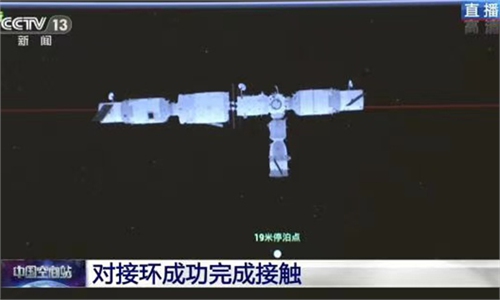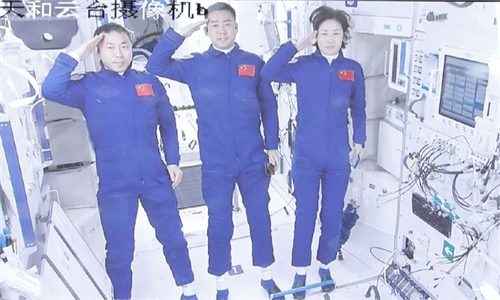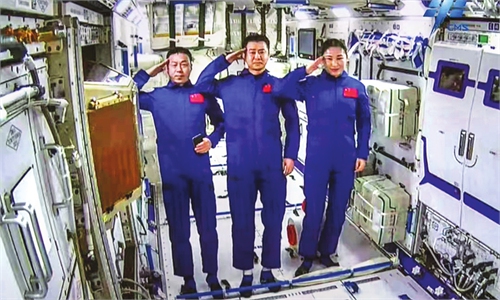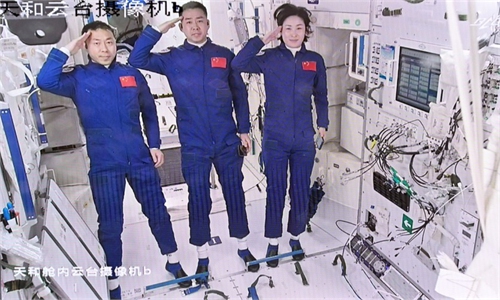Shenzhou-14 crew receives 1st lab module Wentian at China Space Station, verifying country’s ability to assemble ultra-large spacecraft in orbit

A Long March-5B Y3 carrier rocket, carrying Wentian lab module, blasts off from the Wenchang Spacecraft Launch Site in South China's Hainan Province, July 24, 2022. Photo: Xinhua
Some 13 hours after the launch from the tropical island of South China's Hainan Province, China's Wentian lab module successfully arrived at the China Space Station in the early hours on Monday and docked with the Tianhe core cabin, marking the country's first time that two 20-ton spacecraft have completed docking maneuver in orbit.
Wentian, the second section of the three-module China Space Station, was launched on Sunday afternoon on the Long March-5B carrier rocket. After a flight of about eight minutes, the Wentian module separated from the rocket and entered preset orbit, marking the success of the launch mission, the China Manned Space Agency (CMSA) said in a statement to the Global Times on Sunday.
After about 13 hours of flight, the Wentian carried out a successful rendezvous and docking with the front port of the station's Tianhe core cabin, forming a linear combination structure, the CMSA announced.
It was the first time that the taikonauts welcomed a visiting spacecraft. Before China, only the former Soviet Union and the US were capable of assembling ultra-large spacecraft in orbit.
People on Earth shall witness the construction of the China Space Station with an unprecedented speed in mankind's history in the coming months. If all goes well, the Shenzhou-14 crew will be tasked with the most challenging mission in China's manned spaceflight history.
According to the China Aerospace Science and Technology Corp (CASC), upon receiving the Wentian module at the space station, the Shenzhou-14 crew will enter the Wentian to activate the life-support system and complete the installation of scientific equipment to carry out experiments in orbit.
Before the Mengtian, the other space lab that will be launched in October, the Wentian will deck the right side of Tianhe core cabin, forming an L-shaped structure, China Space News, the official joint news outlet of the China Aerospace Science and the Technology Corp and China Academy of Space Technology, reported. For this to happen, the Shenzhou-14 taikonauts will perform three complex steering maneuvers to adjust the Wentian to a vertical position with the help of the robotic arm.
Also, the Wentian will host a new Tiangong Classroom lecture series and the taikonauts will, for the first time, use the airlock in the Wentian module to exit the station for extravehicular activities, the CASC disclosed to the Global Times.
Wentian's visit to the China Space Station carries with it multiple missions. It starts with the complete rendezvous and docking and later a transposition maneuver. Also, serving as a backup for the control and management center, it is capable of covering all task requirements needed for the space station assembly. Additionally, it will better ensure the safety of taikonauts by supporting their extravehicular activities and provide a platform for scientific experiments to be carried out in space.
In normal conditions, the docking process would not need assistance from the taikonauts and they can carry out their own work as usual. Only when an emergency happens at a close distance of the space station will the ground command team hand over the remote control to crews onboard the station for manual operations, Yu Tianyi, Mission Commander for the Wentian, told the Global Times.
Also, for the first time the solar panels on the Wentian have been deployed in two stages with the unfolding of the panels during its individual flight and the rest after the lab module docked to the station assembly.
The reason for this design is that the extraordinarily long "wings" have a full span of over 55 meters, about half of a football field, setting a new record for solar panels used for China's spacecraft. Each panel has an unfolded area of about 110 square meters.
Yu further explained that if the wings are fully unfolded right after the launch into orbit they can compromise the attitude control.




